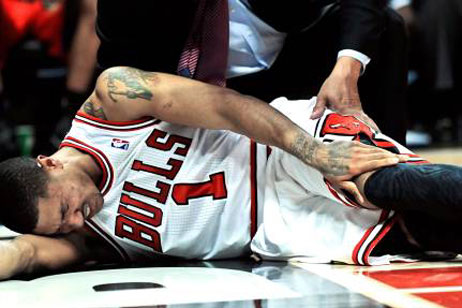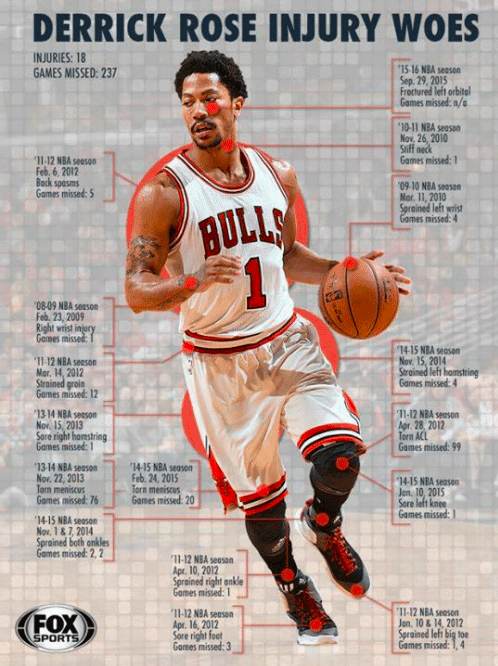Coming back from an injury too soon is an accident waiting to happen.
And our culture of sports has ignored this for far too long.
As a result of coming back too soon, many promising athletes have been cast aside — wearing their new label, “injury prone”.
One example is NFL quarterback, Robert Griffin III (a.k.a. RG3). Another in the NBA, guard, Derrick Rose.
Both athletes returned to play too soon following initial knee injuries.
And the outcome was predictable.
A short time after returning, a domino effect of compounding injuries stole their future stardom. Both were plagued with chronic knee issues and repeated surgeries.
They lost their peak potential and shortened the lives of their careers.
Pro athlete or not, the impatience you experience while sidelined during your injury is your ego. Blind to the bigger picture, it wants to get back in the game — now.
And what is the bigger picture? That you want to be an Athlete For Life.
Ready or not?
Coming back from injury goes well beyond being pain free. And even goes further than completing rehab with a physical therapist.
Being ready is about reaching a point of durability to withstand the rigors of your sport…over time.
Otherwise, the consistent, stressful wear and tear will magnify any lingering dysfunctions caused by your injury
If the wrong parts of your body are loose when they should be stable, or stiff when they should be supple. . .things begin to fray, quick.
If structural imbalances, asymmetries, and faulty movement patterns don’t get corrected. . .it’s only a matter of time until you do more damage.
So don’t just dodge those bullets.
Become bulletproof with the following steps to return from injury.
You’re ready for action once you’ve moved through ALL 7 steps:
1. Zero Pain.
Pain is usually the first signal that lets you know that you’re injured.
But when it fades away, it gives a false impression that your healing process is good enough to get back into action. This isn’t the case.
With that said, being pain-free is an indicator that you’re moving in the right direction. But you’re not out of the woods yet.
2. Complete healing at the location of the trauma.
There are three to four progressive stages of healing tissue. Depending on the tissue type and the severity of the issue, the whole process can take a few months or more.
This doesn’t mean that you can’t return to action sooner. It’s to help you to understand that when you do come back, you must be proactive maximizing recovery.
That means that you have a structured regimen. The basics include nutrition, supplementation, self-massage, stretching, and sleep.
3. Medical clearance.
If your injury warranted seeing a doctor and PT, then they must sign-off to clear you to return. And that’s with no restrictions or limitations.
4. Correct imbalances.
Sports activities are known to promote asymmetries in the body. It’s when the gaps become too great that the body is vulnerable.
Those sports-related gaps, along with other pre-existing asymmetries in your body, can lead to a knockout punch. As they can be major contributors to the initial cause of your injury.
And when you get injured, those asymmetries become exaggerated. This causes new asymmetries to develop.
So there’s much work involved in correcting these muscular compensation patterns.
It’s necessary to detrain these overactive muscles. And that starts with using relaxation methods of isolated rest, massage, and stretching.
You must reinforce detraining with the next step.
5. Retrain functional movement patterns.
Some other aspects to correcting compensations happen through:
Restoring mobility in the joints
Strengthening the underactive muscles
This process finishes with re-educating the body’s coordination in functional movement patterns.
It’s a progression. Slow to fast, simple to complex, light to heavy, short to long, balanced to unbalanced, and so on. The goal is to display the standards of quality to perform your activity uninhibited.
6. Strength and conditioning.
Once you have the foundation of quality functional movement patterns, it’s time to build on it.
It’s likely that you’ll need to be even stronger and better conditioned than you were before you got hurt.
Your body must be able to at least handle the demands (force load + duration) during your sport / activity. And there are anecdotal existing general standards. You’ll find a great example of these standards from my friend, Dr. Chad Waterbury, here.
7. Mental confidence.
An injury can traumatize your athletic psyche. This can cause you to feel uneasy doing what came instinctively before the injury. And lacking this can be dangerous.
Your subconscious mind wants to protect you from further harm. So it’s crucial that you progress with intelligence. This allows you to gain confidence by planning repeated successes.
Skipping any of these steps leads to unwelcome outcomes.
Remember that nobody is going to care as much as you need to about your future as an athlete.
So the responsibility is yours to follow through.
If you missed last week’s post, 2 mistakes to avoid to avoid re-injury, you’ll find it here.
Now, get back to feeling your best. I’m here to help.
Committed to your big picture,
Adam
Header image via: Fadeaway World


